29th Field Hospital Unit History
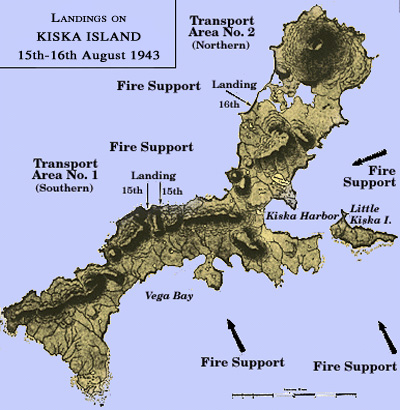
Map illustrating the KISKA invasion and landing sites, including indication of the Northern and Southern Sectors of the island.
Introduction & Activation:
The 29th Field Hospital was activated on 18 September 1942 at Camp Campbell, Hopkinsville, Kentucky (Armored Division camp: acreage 102,414; troop capacity; 2,422 Officers & 45,198 EM –ed). The unit was officially established by Fifth Service Command General Orders No. 73, pursuant to the authority contained in Restricted War Department Letter, Adjutant General 320.2 (dated 6 Aug 42), MR-M-GN, dated 18 August 1942.
The initial period of training and organization took place at Camp Campbell, Kentucky, from 1 November 1942 to 15 May 1943, when the Hospital was ordered to Fort Ord, Monterey, California (Landing Vehicle Board & Army Ground Forces Training Area: acreage 28,690; troop capacity; 51,253 Enlisted personnel –ed), and assigned to Amphibian Task Force # 9. This latter command, after completing amphibious training, undertook the Kiska Island campaign in the Aleutian Islands.
Enlisted personnel fillers (the original cadre –ed) came from various hospitals, and although some of these men had already gone through basic training, most of them had acquired little experience in field and tactical operations, and almost none in medical and administrative work as applied in a regular Field Hospital (this also was true for the Technicians –ed).
25 EM and 1 Officer arrived at Camp Campbell 17 September 1942, from Spence Field, Moultrie, Georgia (building started by the Corps of Engineers 15 Jul 41, operated by the AAF-FTC it also controlled 3 auxiliary airfields in Georgia during WW2 –ed), forming the initial cadre for the new organization. They were followed between 29 September – 1 October 1942, by 28 Technicians coming from Thomas E. Lawson General Hospital (9), John S. Billings General Hospital (4), William Beaumont General Hospital (14), and Robert M. O’Reilly General Hospital (1).
A first official requisition for 165 fillers was submitted under authority of Paragraph 5, Letter, WD, AGO, Washington, dated 8 August 1942, on 16 November 1942. The next month, 28 December 1942, under authority of Telegram, Washington, DC, dated 17 December 1942, signed by Major General J. A. Ulio, The Adjutant General, Paragraph 6, Special Orders No. 147, Camp Campbell Headquarters, dated 24 December 1942, transferred 41 limited assignment servicemen to the organization from the 27th Field Hospital, Camp Campbell, Hopkinsville, Kentucky. These men had had no previous military training and came directly from Reception Centers through the 27th Field Hospital to the unit. It was necessary to study their physical status and fitness to continue serving in a tactical field organization. The new men were received at reveille, the early morning of 28 December 1942, and a 10-week training program based on MTP 8-1 was immediately started the same day.
Medical Officers were assigned and reported for duty with the new organization between 17 September and 21 October 1942, and when the permanent Commanding Officer reported, Lieutenant Colonel Albert E. Hermann, MC, 18 Officers were present, making a total of 19 Officers for the 29th Field Hospital.
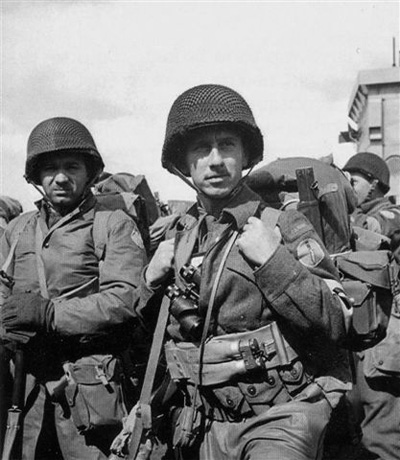
July 1943. Canadian soldiers of the 13th Canadian Infantry Brigade (element of the 6th Canadian Division) being trained in amphibious operations in view of the Kiska invasion.
Number of Medical and Dental Officers – 29th Field Hospital
1 Lieutenant Colonel (MC)
4 Majors (MC)
5 Captains (MC) + 3 Captains (DC)
3 First Lieutenants (MC)
3 First Lieutenants (DC)
On 6 December, 1942, 1 Medical Administrative Corps Officer joined the organization, and by 31 December 1942, aggregate strength reached 21 Officers and 91 Enlisted Men. During the months of January and February 1943, a total of 80 men were received from Camp Barkeley, Camp Grant, and Camp Joseph T. Robinson and immediately absorbed into the running training program, which had expanded under MTP 8-1 and MTP 8-10, to include training for basics, clerks, cooks and bakers, drivers, and Technicians. Including the refresher course for Officers (under MTP 8-10), there were now four programs under way at one time, in part due to the fact that small groups of EM were often received at intervals as fillers. This precluded any attempt at training the unit as a whole, and rendered instruction not only more difficult but also less efficient.
Training:
In order to correct the lack of proper medical training, a 44-hour training program was started 1 November 1942. The Officers had all had some training in Army General Hospitals before, for periods ranging from 3 weeks to 2 years, yet they lacked field training. Only 2 Officers had followed 1 month training at the Medical Field Service School, Carlisle Barracks, Pennsylvania. Therefore, it was necessary to start a training program based on MTP 8-10. It should be noted that those Enlisted Men who received training as Specialists were especially fortunate in having instructors who were well-qualified by civilian experience. Several Officers had previously instructed in medical schools and institutions, and two of them had considerable experience with engines and trucks. The Camp School for cooks and bakers, and the Station Hospital facilities were used extensively. Two of the Officers were sent to the Chemical Warfare School at Edgewood Arsenal, Maryland, where they received 4 weeks of training in gas warfare and treatment of gas casualties and 1 Officer was sent to the University of Tennessee, Memphis, Tennessee, for 6 weeks of training in x-ray equipment and technique. Two (2) more Officers were sent on specialized training, one to Columbia University, New York, for a course in anesthesia, and the other to the University of Tennessee, Memphis, Tennessee, for a course in laboratory technique. During March and April 1943, EM were sent on SD to learn ward procedure and operating room and laboratory techniques. The men trained for a period of 4 up to 12 weeks.
Unfortunately, training for both Officers and Enlisted Men was handicapped by the lack of sufficient training equipment and difficulty in securing manuals and copies of Army Regulations, but with some improvisation, simulation, and loans obtained from the Post Surgeon, the training program was implemented. The meeting of this rather difficult and embarrassing situation by the usual ingenuity presaged the ability of the unit’s personnel “to deliver” under adverse situations. The unit’s transportation section was formed in December 1942 with supply of a few vehicles. Their numbers would gradually increase the first two months of 1943, until it became possible to transport the whole organization by shuttling. Valuable training and training marches involving logistic problems certainly helped drivers and mechanics acquire more experience and stimulated the personnel to improve their skills. The ability to entruck and detruck efficiently and swiftly, and a decent organization of the transportation of supplies and equipment, made maneuvers and field exercises relatively easy.
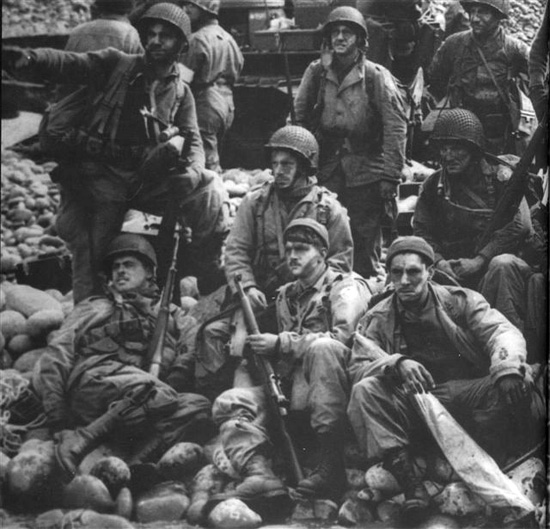
Illustration showing part of a combat section pertaining to the joint American-Canadian First Special Service Force taking some rest at Quisling Cove, Kiska Island, 15-16 August 1943, after spearheading the assault.
The first bivouacs were organized as from 22 February 1943, but lasted less than 24 hours due to heavy snowfall. As the weather improved, regular bivouacs were conducted for 2-3 days every week, regardless of the weather, unless the roads were actually rendered impassible (anyway, rain, snow, and mud were all endured and largely overcome). Since terrain varied enormously, at times flat and open, at times hilly and wooded, some adaptation and improvisation was mandatory. Corduroy roads and rough bridges had to be constructed, and extensive ditching was sometimes necessary. At all times, the importance of speed, security, and efficiency was stressed, and special emphasis placed on cover, concealment, protection, and camouflage. During March 1943, 4 Officers were transferred out of the unit, and 11 EM were discharged on the basis that they were over 38 years of age. By the end of March, some compensation for the loss was received when 39 fillers joined from Camp Joseph T. Robinson, Little Rock, Arkansas. Official strength as per 31 March 1943 was 17 Officers and 259 Enlisted Men.
Two MAC Officers joined in April, and were respectively appointed Transportation Officer and Personnel Officer. Another Medical Officer went to the Army Medical Center, Aurora, Colorado, to take a course in tropical medicine. Another personnel loss was sustained as on 17 April 1943, a group of 14 EM were discharged from the Army, as being capable of employment in essential war industry and agriculture (under provisions of WD Circular No. 92, 1943 –ed). 4 additional Enlisted Men were sent to Ohio State University, as members of an ASTU (Army Specialized Training Unit –ed). After an exhaustive inspection to determine the readiness of the Hospital (30 February 1943), the official strength of the 29th Field Hospital was consolidated as being 19 Officers and 242 Enlisted Men.
Relations with Post Headquarters and the Camp Surgeon were cordial and there was a genuine desire by these authorities to aid the Hospital in equipment and training subject to their own limitations and requirements. Frequent hikes and marches were held to improve the men’s overall physical condition as it was the desire of the CO that the entire organization be further seasoned by long marches and bivouacs. Some adjustments as far as climate had to be made during training because of the rainy weather, and mud in the drill and tent pitching areas. In general however, the training program was carried out without too many serious climatic complications.
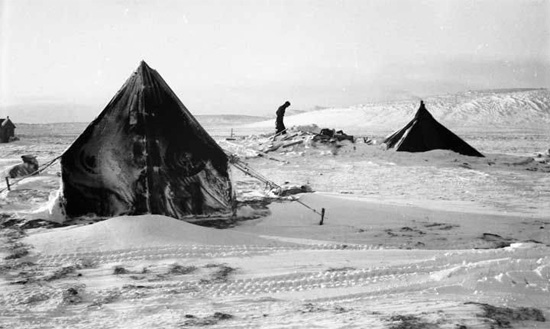
Supply Tents in the snow, picture illustrating the barren living conditions and hostile environment in the Aleutians.
The official training period was concluded on 15 May 1943.
Camp Campbell, Kentucky:
As far as housing was concerned, three buildings of the cantonment type were available, with two stories, for the Enlisted Men, and a headquarters and a mess hall were found to be adequate and satisfactory. Water supply and bathing facilities were ample, and came from wells, the Red River, and springs. All facilities were furnished by the Post Engineers. The Quartermaster Corps supplied the necessary laundry, which became available early in October 1942. At times, return was slow due to insufficient personnel.
During the month of October, for reasons unknown, it seemed that less meat was available than was required by the ration. This was gradually corrected and food and messing were found to be entirely satisfactory, with the well-recognized fact that the EM mess proved superior to that of the Officers.
Sewage disposable was furnished by the existing Post facilities, controlled and serviced by the Post Engineer, with no breakdowns at any time. Garbage disposal and removal of other wastes was also arranged for by the responsible Post Engineer Officer on a regular and adequate basis, and flies never caused any difficulties. Insect control was never a problem as far as could be ascertained.
Military authorities had established near the Post, in neighboring communities, an adequate number of Pro Stations, and although it was known that the VD rate was high in the communities, there was not a single case of venereal disease in the organization. Sex morality lectures and movies had a salutary effect on the personnel.
Recreation was limited to motion pictures not less than two miles from the units’ area, but since no transportation facilities, other than walking, were available, many an Enlisted Man returned to his barrack badly splattered by Camp Campbell rain and mud (later, other theaters were opened by the Post nearer the EM’s area). Patronized service clubs existed, a good restaurant was open and prepared excellent food at reasonable rates, dancing, music, ping-pong, and card games were all available and free to all. Occasionally, arrangements were made for groups to visit homes in adjoining communities, which proved helpful in building morale. Sports, such as boxing, basketball, and other games were started and under way.
Protestant, Jewish, and Catholic services in the chapels were attended by the men. In general, it could be stated that the Post Commander had done all he could to make off-duty hours of the Enlisted personnel at the camp pleasant.
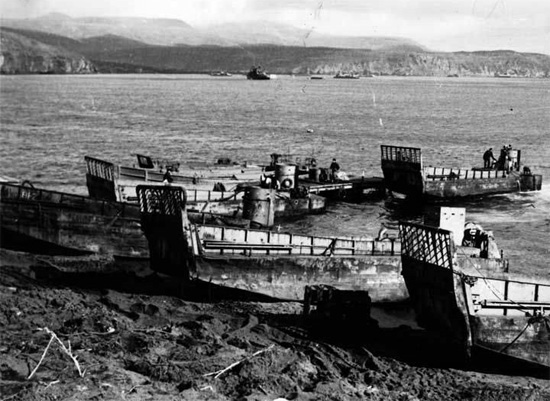
August 1943. View of disabled landing craft at one of the invasion beaches, Kiska Island.
Change of Station:
The Hospital was alerted for a change of station, while on bivouac, on 5 May 1943. Leaves and furloughs were immediately cancelled, and all Officers and Enlisted personnel recalled. In order to correct some lack of professional qualifications among Officers, 2 of them were exchanged with the Station Hospital, Camp Campbell, for two Officers with sufficient surgical training.
On 15 May 1943, orders were received, as per Letter Order, Camp Campbell, Kentucky, File No. 370.5, for Movement to Fort Ord, California, for further training. On the same day, 27 Enlisted Men joined from the Station Hospital. Following a number of fluctuations, modifications, and transfers of personnel, the organization lost 1 MAC Officer and 26 EM on 19 May 1943, all transferred to form a cadre for the 39th Field Hospital. They were all temporarily attached to the 30th Field Hospital for quarters and rations, awaiting orders to proceed to their new station.
The remainder of the unit, actually comprising 9 Officers and 215 Enlisted Men, entrained at 0915, 19 May 1943 (with 8 Officers traveling in advance, and 1 Officer accompanied by 4 EM going with the vehicles and equipment on a separate train -ed).
The 29th Field Hospital arrived at Fort Ord, Monterey, California, on 23 May 1943, and detrained at 1700 hours. The unit was assigned to quarters in wooden barracks, and attached to ATF # 9 the next day, upon verbal orders received from the Commanding General, Amphibian Task Force # 9, with which it was to start an extensive training in amphibious warfare. The programs were to embrace all possible phases of this special warfare including maneuvers with Battalion Landing Groups, designed to demonstrate the place of the Field Hospital in such operations. One phase of the instruction which was enthusiastically received by the entire command was the care and use of firearms. A short familiarization course was given followed by live firing on the range. In all, each man spent 4 days on the subject. On the day, that the organization’s 3 Hospitalization Units left Fort Ord, California for the San Francisco Port of Embarkation, the whole command was issued arms. The distribution for each Platoon was as follows:
.30 Caliber M-1 Rifles – 53
.45 Caliber Thompson Submachine Guns – 22
.45 Caliber Auto Pistols – 2
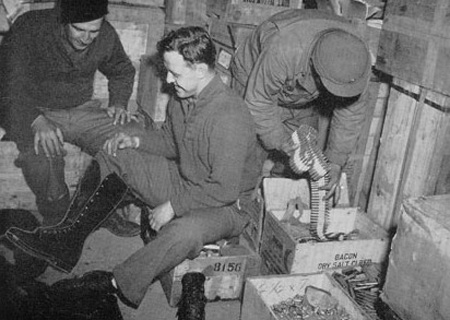
New boots are supplied to personnel on Kiska Island after occupation. While the NCO supervises fitting, another soldier at right verifies belts and contents of ammo boxes.
This was the first time in American military history that a medical unit was deliberately armed before battle. Although in contradiction with Geneva Convention regulations, the effect on the morale of the Enlisted Men was salutary and immediate.
On 26 May 1943, a filler of 18 EM (all Technicians 5th Grade) joined the command from William T. Fitzsimons General Hospital, Denver, Colorado. These men were in lieu of the 18 (female) Nurses called for by T/O & E 8-510, dated 28 February 1942 (total personnel strength as per T/O 8-510 indicated 17 Officers, 18 Nurses and 211 Enlisted Men –ed). The reason was that the Nurses were found to be in various stages of training, and could not replace fully-trained Nurses; furthermore, they had served in General Hospitals for many months, but were not in physical condition for field service. In order to allow for further clearing of the unit, 20 EM joined on 8 June 1943, from various units in ATF # 9. As most of them were infantrymen, they had received no training as medical soldiers.
On 25 June 1943, the 591st Medical Hospital Ship Platoon was attached for QRA (this attachment was to continue until 8 July 1943, when the unit was ordered back to the San Francisco POE, California –ed). One last Officer joined from Jonathan Letterman General Hospital, San Francisco, California, on 1 July 1943, and 1 Officer was transferred to the 37th Coast Artillery Corps Brigade, because of physical disqualification on 5 July. The constant changes, and the confusion that followed the formation period of ATF # 9, were reflected in the training at Ford Ord. The unit was consequently broken down into four different units, being the 3 Hospitalization Units, and the Headquarters Section and then attached to separate Battalion Landing Groups, thus becoming autonomous under the BLG Commanders. The plans of each BLG were often changed, sometimes daily, and on several occasions went through 2 to 3 revisions in one single day! To make matters worse, the assignment of the 29th Field Hospital Platoons (read Hospitalization Units –ed) to the BLG was changed in the middle of the training period with detrimental results. Part of this confusion apparently resulted from a complete lack of knowledge by higher echelons, of the function, the capabilities, or the limitations of a Field Hospital.
Another problem that occurred was that during training in amphibious landing from ships (mainly LSTs –ed), a determined effort was made by the Battalion Landing Groups to include medical equipment of the Field Hospital (Item No. 97227 –ed) and to practice landing and unloading procedures. Unfortunately these efforts were successfully opposed by the CO, on approval of The Surgeon in Washington DC, on the basis that such handling would inevitably lead to loss or damage to expensive and vital equipment. After final inventory and check, it was necessary to divide ALL items, except the x-ray equipment, and repack and crate it into 3 identical groups. When about half of the crates had been completed and repacked, new orders came in for waterproofing all crating. This brought about extra labor and materials, and resulted in hurried last minute packing, not always efficient from the functional standpoint. During the training period at Fort Ord, California, no training was lost due to inclement weather, the only annoyance being fleas in the sand which could be overcome. VD caused no problem, as there were no cases among the command while the unit trained there. The personnel’s teeth were checked and all customary immunization procedures involving typhoid and tetanus in preparation for overseas movement were likewise carried out. Several inspections by Headquarters took place, and last-minute suggestions with regard to personnel, training, and equipment given. The Medical Supply Officer’s personal efforts to fill original and initial lists of shortages were of great value to the organization in this period.
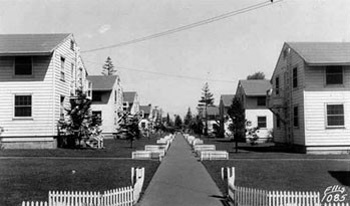
Partial view of personnel barracks at Fort Lawton, Seatlle, Washington. This is the place through which the 29th Field Hospital transited after its return from the Aleutians, end of February 1944.
First Movement Overseas:
On 9 July 1943, the 3 Hospitalization Units (aka Platoons –ed), numbering 15 Officers and 216 Enlisted Men, departed Fort Ord, California, at 2000 hours, bound for San Francisco’s Port of Embarkation. The Headquarters Section, consisting of 3 Officers and 24 EM, remained until 16 July, when it also departed for the same destination. With the latter’s move, total strength of the 29th Field Hospital reached 18 Officers and 235 Enlisted Men.
The 3 Platoons embarked at the POE between 0030 and 0200, 10 July, sailing at 0700 hours, 11 July 1943. All troops were aboard LSTs: First Platoon > LST 483, Second Platoon > LST 478, Third Platoon > LST 481. Organizational equipment was divided among the three units, and in the case of the First and Second Platoons, was further spread over two ships. In addition, all housekeeping equipment was shipped under separate numbers, so as to make it readily available for use at the landing point.
On 21 July, the invasion flotilla arrived at Kodiak, Alaska where it berthed after a rough journey at sea. It departed Kodiak at 1750 and after a calm voyage reached Adak, Alaska on 26 July 1943. Two days later, the command left Kulak Bay in the early morning and dropped anchor at the Bay of Isles, Adak, Alaska, around 1700 hours of the same day. On 29 July the Hospital’s 3 Platoons debarked and went into bivouac with the BLG to which they were separately attached. The Headquarters Section had meanwhile embarked on LST 20, at 0100, 17 July 1943, arriving at Kodiak on 25 July, and after a stop, finally reached the Bay of Isles, Adak, by 5 August. It debarked the following day and went into bivouac with other units attached to ATF Headquarters. The period spent in bivouac at Adak, Alaska, was of great value, since it allowed the separate Hospitalization Units to function independently under the respective Platoon Commanders. It served as a test to the personnel in their assigned duties and developed administration and supply to states of higher efficiency. It proved invaluable for Officers to know their counter parts with whom they would have to operate in the field, and allowed them to evaluate each others’ capabilities. Unfortunately, part of the value of this particular training phase was completely lost by a change in alignment of BLGs, resulting in the removal of the First Platoon to a different sector from Headquarters Section and the Second and Third Platoons. This resulted in a mixing of personnel and equipment of the 28th Field Hospital and the 29th Field Hospital, each one suffering by the exchange because of ignorance of the abilities and limitations of the Officers and EM involved. Commitments were such that there was no possibility for the First Hospitalization Unit of each of the Field Hospitals to rejoin their own group until the end of the campaign! Although the Commanding Officers of both the 28th and the 29th Field Hospital objected to this move, they were overruled by the Task Force Surgeon, Lieutenant Colonel H. E. Bill, MC (for further data re the Kiska Invasion, please revert to our Unit History of the 28th Field Hospital).

Picture illustrating troopship “General William Mitchell”, AP-114, which carried the 29th Field Hospital across the Atlantic to the United Kingdom in May of 1944.
Following the mix up, First Platoon of the 29th Field Hospital, joined the Composite 28th Field Hospital, while Headquarters Section, Second and Third Platoons of the 29th Field Hospital, with First Platoon of the 28th Field Hospital attached, formed the Composite 29th Field Hospital under command of Lieutenant Colonel Albert E. Hermann, MC.
Kiska Island:
First Platoon, split into 2 sections, embarked on LST 482 and 483, 10 August 1943, and departed the Bay of Isles, Adak, Alaska, 11 August, arriving at Amchitka, Alaska, on 12 August 1943. It left Amchitka again on 13 August, and arrived off Quisling Cove, Kiska, at 0200 hours, 15 August 1943. A pioneer party of 1 Officer and 14 EM debarked at 0830, but found no need for establishing a Field Hospital, due to few casualties and adequate care by Navy medical personnel. They followed the main assault group in a southerly direction across the island where they were placed under command of the Surgeon, Southern Sector.
The remainder of First Platoon remaining on board departed from Quisling Cove 19 August, and arrived at Gertrude Cove in the same afternoon, but did not land until 0900 on 22 August 1943. It joined the pioneer party and reported for duty to the CO of the Composite 28th Field Hospital. Following instructions, tents were erected, equipment unpacked, and the station was opened at 2000 hours of the same day.
Second Platoon, also split into 2 sections, embarked on LST 478 and 479, 8 August 1943, and departed from the Bay of Isles, Adak, Alaska, 9 August, arriving at Kulak Bay, the same day. It left Kulak Bay 13 August, and arrived off Broad Beach, Kiska, at 0300 hours, 16 August 1943. LST 478 was beached at 1600, but supplies and personnel remained on board.
Third Platoon, embarked on LST 481 at 1900, 11 August 1943, and departed from the Bay of Isles on 14 August, reaching Broad Beach, Kiska, at 0400 hours, 16 August 1943. Troops did not land.
Headquarters Section, embarked on LST 29 at 1600, 13 August 1943, sailed from the Bay of Isles, Adak, the next day, and arrived off Broad Beach, Kiska, at 0430 hours, 16 August 1943. Equipment and personnel debarked at 1215, 17 August, and went into bivouac with First Platoon, 28th Field Hospital in the area assigned by the Northern Sector. The necessary pyramidal tents were pitched and the Station Hospital was reported open to receive 16 patients at 2000 hours the same day.
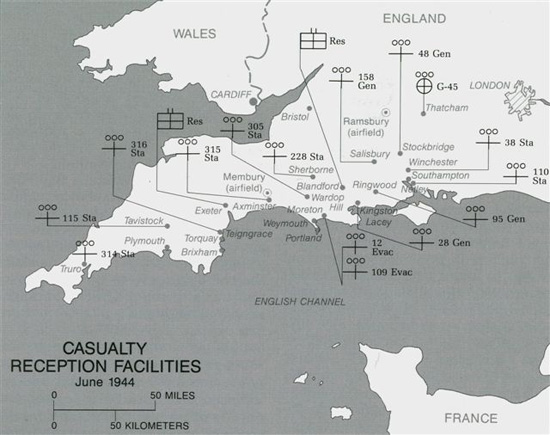
Map illustrating the casualty reception facilities established for the reception of wounded from the Normandy Invasion. The different Base Sections in southern England set up Field Hospitals (when necessary, supplemented by other medical units) under canvas or in requisitioned buildings to serve as Holdings Units for inland or direct Rail and/or Air Evacuation.
The Composite 29th Field Hospital (minus its Second and Third Platoons), remained operational at Broad Beach, Kiska, until 22 August 1943. During that period it received 50 patients from various sources, performed one major surgical operation, returned 39 casualties to duty, evacuated another 8 patients to the Navy Beach Party Medical Section, and finally transferred 3 cases to the 6th Field Hospital in operation adjacent to it. The operational environment was extremely difficult, with exposed, rugged, and wet terrain. Moreover, all supplies and equipment of all sorts had to be back-packed from the landing beach through a sea of mud, knee-deep, over fairly large areas. All of this evidently affected the overall efficiency of the organization and would no doubt have limited its capacity if any number of battle casualties had been sent to it for treatment. Fortunately, this was not the case! Reports of these difficulties were forwarded on two occasions, 8 September and 17 November 1943, to the Task Force Surgeon, with apparently no reaction. Headquarters Section and First Platoon, 28th Field Hospital, closed station 22 August, and crossed the island to Kiska Harbor, which they reached at 1600 hours. The personnel slept aboard LST 20, which was especially beached that night. Second and Third Platoons departed Broad Beach 19 August at 2000 and arrived in Kiska Harbor the next day. LST 481 with Third Platoon still on board beached on 21 August, and LST 478 with half of the Second Platoon, beached the following day. It debarked on 23 August 1943, and eventually joined Headquarters Section. The Composite 29th Field Hospital, less one half of Second Platoon, was then marched with heavy loads over rough terrain about two miles to the site selected by the Commanding General at the head of Trout Lagoon. The remainder of Second Platoon landed from LST 479 and rejoined the unit on 26 August.
First Platoon, 28th Field Hospital, and First Platoon, 29th Field Hospital, were finally exchanged on 8 September 1943, with each unit returning to its original composition. Aggregate strength at this time was 18 Officers and 235 Enlisted Men.
The Hospital was then ordered to prepare the site for the permanent Station Hospital and while tentative plans were outlined by the Task Force Commanding General, sites for hospital tents were excavated. At the same time, the necessary supplies and equipment were transported, at first by back only, over long hills, from the landing beach in Kiska Harbor. Attempts to secure transportation were refused until the CG was appealed to directly. In the end, one T-15 snow jeep was promised, but not forthcoming for three more days. Without transportation it was clear that the Field Hospital could not operate properly. The situation with respect to supplies was little better at Kiska Harbor, and it was necessary to mount armed guards over the equipment wherever it might be, to prevent looting or theft. In spite of the efforts, several boxes containing vital equipment were lost. Personnel were quartered in double M-1934 pyramidal tents on the north wall of the valley, with tent sites being scattered from the valley floor to as much as 300 feet up the steep hillside. The resulting dispersion made excavation easier but no doubt increased the labor and distance involved in getting to and from the various tents, and in bringing the necessary coal ration to them. It also increased hazards of being caught in the open in inclement weather. Winterizing efforts were delayed pending the final decision whether the unit was to move or not to some other area. By end of November, the supply of lumber had been largely exhausted and the ground frozen, causing more hardship. In spite of these difficulties, the personnel managed to build walls to support the tents and secure boards to install adequate flooring in them. Sanitation was a distinct problem at first, until proper ditching provided every tent with its own supply of water for washing. An adjacent water supply depot provided chlorinated water for drinking and for the mess. Latrine contents were collected in empty oil drums, burned and ashes buried, although this produced a terrific stench (more or less solved by placing the barrels down-wind). A large grease trap and soakage pits were built, and later a shower bath was set up for the command, entirely constructed of waste materials. With water being supplied from a nearby spring, the personnel and staff could enjoy hot showers twice a week. Radios and movies provided for limited recreation. One of the ward tents was used as a chapel for all troops in the Trout Lagoon area and doubled for occasional amateur theatricals or shows, produced by the unit’s members. Mental occupation was essential during a period of relative inactivity and a hostile environment. A mobile laundry was made available, and by excavating a site for pitching seven tents in a row, a large and permanent mess hall was created for all ranks (it was finished in time for Thanksgiving –ed). The mess department served a delicious dinner, complete from appetizer to ice cream, with fresh turkey available in sufficient amounts.
On 14 December 1943, the unit’s dental equipment was unpacked and a clinic opened to provide dental care for the whole organization, including men from nearby small units. A double pyramid tent provided adequate space for two chairs and a small lab. Despite the limited medical activity, employment of the personnel remained almost continuous! Large work details were called to do engineering labor in Kiska Village and elsewhere, and most of the time the men were used to unload or load ships in Kiska Harbor. The Hospital supplied labor details to help construct the 210th Station Hospital and to dig drainage ditches or build sidewalks, install stairs, maintain roads, drive trucks, and even repair and drive amphibian vehicles and bulldozers, store rations and supplies, handle ammunition, and operate salvage teams (much work was done by hand and with the help of a small supply of dynamite and nitrostarch –ed). Christmas was celebrated the traditional way be it slightly modified by the local conditions, with an excellent dinner served in the evening in a decorated mess hall enlivened by a genuine Christmas tree.
By 31 December 1943, the unit ended its sixteenth month of activity with 17 Officers and 235 Enlisted Men (being 1 Officer under strength –ed).
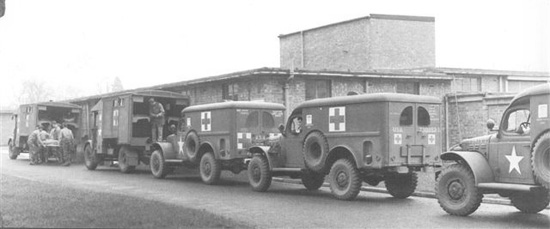
Somewhere in England, July-August 1944. Lineup of mixed British Austin and American WC-54 Dodge ambulances, waiting to pick up patients for evacuation.
The first phases of the Hospital’s activities were characterized by undirected efforts to train for a function that was poorly indicated by meagre directives. The 29th Field Hospital was to be trained as a highly mobile medical installation of the Station Hospital type, but did not receive the opportunity to become familiar with medical equipment. The later phases were remembered as typified by confusion, hesitation, and a lack of comprehension by higher echelons of the organization, function, and role of a Field Hospital. Frequent changes of assignment, and shuffling of units with those of another Field Hospital (the 28th Fld Hosp –ed), interfered with training and resulted in a marked loss of efficiency. The deficiencies were particularly reflected during the Kiska operation. While the assigned job was accomplished under much difficulty, it was concluded that careful and foresighted planning, based on experience and knowledge would have solved many of the problems. Since no enemy opposition had been encountered, the unit scarcely functioned in its medical capacity but rather expended its energy with the personnel being used as common labor (shortage of manpower on the island –ed) for improving the physical aspects and the comfort of the bivouac site on Kiska Island. The overall experience gained seemed to have served some useful purpose for later operations, but it missed the opportunity to further train Medical and Surgical Technicians as they were only employed in the unit Dispensary.
The 29th Field Hospital returned to the continental United States 20 February 1944, arriving at Seattle POE, debarking at 1600 hours, and being subsequently transported to Fort Lawton, Seattle, Washington. After spending four days at the Post, the unit was transferred to its permanent station, Camp Bowie, Brownwood, Texas (Armored Division Camp: acreage 116,264; troop capacity: 2,237 Officers & 43,247 EM –ed) 29 February 1944. Upon arrival, the organization was informed that a very early readiness date had been received for its movement to another overseas assignment. As a result of this, the 29th Field Hospital left Camp Bowie for a Staging Area on 20 April 1944, just two months after returning in the Zone of Interior.
Camp Bowie, Texas:
Arising out of previous experiences on Kiska Island three problems were to be first considered at Camp Bowie.
- Reorganizaton of the 29th Field Hospital, based on T/O & E 8-510, dated 15 September 1943.
- Transfer from the unit of certain personnel found by trial to be unfit for field duty.
- Further training by way of refresher courses with a duration of 6 to 8 weeks for the Medical and Surgical Technicians, who by reason of their employment as a labor force on Kiska, had lost touch with the work for which they had originally been trained for.

1 > Admission-Disposition Office (Ward Tent)
2 > Shock Tent (Ward Tent)
3 > Sterilizing-Scrub Room (Pyramid Tent)
4 > Surgery-Operating Rooms (Ward Tent)
5 > Generator (Pyramid Tent)
6 > X-Ray-Plaster (Ward Tent)
7 > Ward A (Ward Tent)
8 > Medical Supply (Ward Tent)
9 > Ward E (Ward tent)
10 > Ward D (Ward tent)
11 > Ward C (Ward tent)
12 > Ward B (Ward Tent)
13 > Unit Supply (Ward tent)
14 > Pharmacy-Lab (Ward Tent)
15 > Ward G (Ward Tent)
16 > Ward F (Ward tent)
17 > Gas Decon (Ward Tent)
18 + 19 > Patients Mess (Ward Tent)
20 > Personnel Mess (Pyramid Tent)
21 + 22 > Stores (Pyramid Tent)
23 > Officers Mess (Pyramid Tent)
24 + 25 > Bachelor Officers Quarters (Pyramid Tent)
26 > Command Post & Headquarters (Pyramid Tent)
27 > Workshop (Pyramid Tent)
28 > Transportation Section (Pyramid Tent)
29 > Noncoms (Pyramid Tent)
P > Personnel (Pyramid Tents)
L > Latrines (Screens)
S > Showers (Pyramid Tents)
A > Ablutions (Wooden Benches)
With respect to the reorganization, it was found out that the updated T/O & E 8-510 had already been authorized in the movement orders received shortly after arrival at Camp Bowie. In fact, several EM were promoted before the remainder of Officers and Enlisted Men went on 20-day laves and furloughs. However, the drawback was that the same order specified that the 29th had to be ready to move again by 1 April 1944, which precluded any attempt at further training of the Technicians!
Inspectors of the Eighth Service Command corroborated that some refresher training should be formulated, and after the readiness date of the unit was amended to 15 April, it allowed about two weeks for training in technical procedures and reviewing of basic and tactical subjects. A further reorganization was rescinded accompanied by the revocation of orders recently promoting a number of Enlisted personnel. 18 ANC Officers who had been recently assigned for training with the unit were transferred out. The conclusion was that the 29th Field Hospital was ordered to proceed to the Staging Area in its present state of training and with personnel according to T/O & E 8-510, dated 20 February 1942. The only change that came through was that 5 Officers and 20 EM were lost for physical or other reasons, to be later replaced. Total unit strength on 20 April 1944 was 17 Officers and 233 Enlisted Men (and no Nurses).
Second Movement Overseas:
After arriving at Camp Kilmer Staging Area, Stelton, New Jersey (Staging Area for New York POE: acreage 1,815; troop capacity: 2,074 Officers & 35,386 EM –ed) on 23 April 1944, a little over a week was spent in clearing and processing for overseas movement. The unit embarked on the “General William Mitchell”, AP-114 (troopship, commissioned 19 Jan 44, served in the European, Mediterranean and Pacific Theaters, and continued to operate during the Korean War –ed) on 2 May at the New York POE, with a strength of 17 Officers and 235 Enlisted Men, sailing the next day. Aside from providing Dispensary care for the Army personnel traveling on board, there was little activity. Quarters for Officers and EM were satisfactory, but the Enlisted mess was not up to the usual Army standards.
United Kingdom:
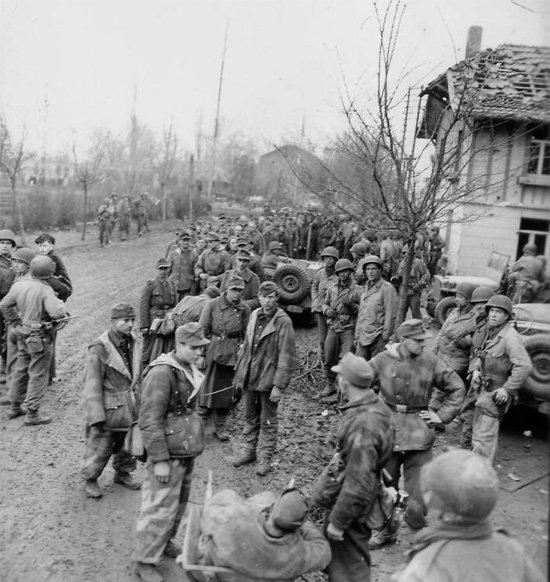
April-May 1945, somewhere in Germany. German soldiers surrender to American troops; for them the war is over.
On 14 May 1944, the USS “General William Mitchell” anchored off Greenock, Scotland, and discharged its personnel; a detail of 1 Officer and 5 EM was left to see to the unloading of the TAT equipment while the unit entrained en route to the Provisional Medical Training Area at Llandudno, Wales, where it arrived at 0740 hours, 15 May 1944. Officers and Men were immediately billeted in private hotels and attached to the MTC for rations. The following day instructions were received assigning the organization to the Western Base Section, United Kingdom, and given the following mission:
- First Hospitalization Unit (or Platoon), was to activate and operate an Air Holding Station of 90 beds and a 10-bed Dispensary at Prestwick, Scotland (ATC terminal –ed), for the evacuation of patients to the Zone of Interior. First Platoon operated Westfield House while the Hospital Train No. 18 was reinforced by elements of the 811th Medical Air Evacuation Squadron who manned the Air Base. First Platoon eventually left for Ayre, Scotland, on 22 May 1944.
- Second and Third Hospitalization Units, were to mount the D-Day Invasion by setting up two Transient Hospitals under tentage, each capable of holding at least 100 patients. One was to be located at Newport, and the other at Morriston, near Swansea, South Wales.
On 22 May 1944, the First Hospitalization Unit, consisting of 5 Officers and 72 EM left Llandudno, Wales, and arrived at Westfield House, Scotland. An advance group of 2 Officers accompanied by 20 Enlisted Men pertaining to the 99th General Hospital had arrived two weeks before for the purpose of preparing the buildings for occupation. It was discovered that due to many factors very little had been accomplished and supplies had barely begun to arrive. The Engineers had been hindered by the delayed departure of the preceding RASC occupants, consequently the Enlisted personnel were billeted in a free section of Westfield House and the Officers in private homes in the city. Mess and food facilities were fortunately available at the Prestwick Air Base, run by the Air Transport Command.
On 3 June, the Platoon was notified that the Crowley-Russell camp site (an abandoned labor camp –ed) at the Prestwick Air Base had been acquired by the American Forces in the United Kingdom and would be prepared for similar use as the Westfield House. Its bed capacity was estimated at 156. Consequently, both sites were put under the command of the First Hospitalization Unit, 29th Field Hospital, accommodating a total of 256 beds. 3 Officers, 6 Nurses, and 35 Enlisted Men coming from Hospital Train No. 18, arriving 7 June 1944, supplemented the Holding Unit.
The first patients arrived on 9 June, with the building prepared for admission, a partial mess organized, and the major administrative details effected; but these really met only minimal standards, which did not comply with ETO requirements. Further work was delayed and rendered more difficult by the acute shortage of the necessary materials and the fact that the building was inadequate and unsuited for the assigned mission in respect to the number of latrines, the poor sewage system and incomplete kitchen washing facilities. Pending finalization of the works, the Crowley-Russell site only started operations on 22 June. The majority of patients were non-battle casualties evacuated from General Hospitals stationed in the UK. Casualties from the Continent, including some D-Day patients, only began arriving toward the latter part of the month.
On 24 July 1944, First Platoon strength was reduced from 72 men to 56, and 15 excess EM were dispatched to the 10th Replacement Depot for reassignment. To compensate for this loss, 4 Officers, 6 Nurses, and 39 Enlisted personnel from Hospital Train No. 25 were assigned to the organization, arriving on 26 July.
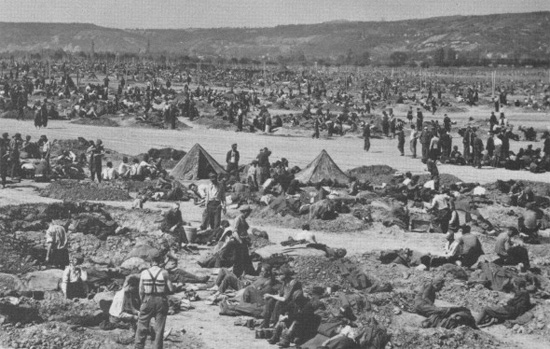
12 May 1945, Germany. View of PWTE A-5, at Sinzig, Germany. This particular Prisoner of War Transient Enclosure (designated under the German name Rheinwiesenlager) held 116,000 German PWs. They were grouped within a barbed wire fenced open field with little or no shelter, and went almost without decent food or water. A total of 19 such enclosures were set up holding over 1,000,000 enemy PWs.
In August, it was decided by the Office of The Chief Surgeon that the existing and anticipated demands for air evacuation to the ZI had far outgrown the capacities of both Westfield House and the Crowley-Russell sites, furthermore the available personnel was considered inadequate! A new site was procured; the North Building, situated on the Air Base grounds with a capacity of about 375 beds, with expansion facilities for the extra accommodation of over 400 patients, and with many additional installations as x-ray, operating rooms, American Red Cross, dayrooms, and a more satisfactory briefing room.
Following instructions, the Hospital Train No. 18 was relieved 7 August; the personnel of Hospital Train No. 25 followed on 17 August, and the last unit to go was First Platoon, 29th Field Hospital which left on 26 August 1944. All three units were relieved and replaced by the 57th Field Hospital.
Evacuations – First Hospitalization Unit
June 1944 – 653 patients
July 1944 – 3,600 patients
August 1944 – 3,002 patients
One of the problems that occurred was that the TAT equipment consisting mainly of housekeeping items had not yet arrived, and medical equipment as well as supplies, such as canvas tents had not been obtained. While immediate steps were taken by the Western Base Section to secure adequate tentage and supplies to operate the installations, both Platoons and the Headquarters Section were ordered to Govilon, Wales, and attached to the 279th Station Hospital for rations and quarters. Medical equipment, Item No. 97227, had already arrived at Govilon, and while it was being sorted out, a partial issue of vehicles was obtained including four 1½-ton personnel and cargo carriers, replacing the 2½-ton trucks. Tents were picked up as well, and enough equipment was finally obtained so that on 25 May 1944, the Headquarters Section and the Third Platoon could move to Morriston, as cellular units, to establish the 100-bed Transient Hospital. The station opened for the reception of patients between 2 June and 10 June 1944, although no casualties were ever received!
Second Platoon opened at Morriston from 3 June to 10 June 1944, and received 26 patients but none were battle casualties.
Both Hospitalization Units and the Headquarters Section were ordered by District Headquarters to close camp and move directly to Landover, England, on 15 June 1944. Equipment was packed and crated, loaded and unloaded at the new site the same day. This was a change from canvas to tiled construction and Nissen huts on the unoccupied grounds of an Estate (except for the presence of an Ambulance Company and a handful of Army Engineers). The following day, orders were received to leave Landover for Kington, England, where its mission was to aid Detachment A, 1st General Hospital (consisting of 12 Officers, 20 Nurses, and 150 Enlisted Men –ed), setting up a General Hospital at Hospital plant No. 4180. Personnel moved on 17 June 1944, without equipment (no transportation available). A large part of the personnel of the 29th was however returned to the parent unit. It left the 29th Field Hospital (less First Platoon) plus 12 Officers and 164 EM and Detachment A, 1st General Hospital, with 7 Officers, 20 Nurses, and 50 EM to operate a 300-bed General Hospital together. This operation however proved invaluable, since this was an excellent opportunity to refresh those who had served on Kiska and to learn the procedures and techniques involving patients subsequently admitted.
On 10 July 1944, Letter Adjutant General, 322 AGM, Headquarters, Western Base Section, Communications Zone, ETOUSA, dated 1 July 1944, was received authorizing the entire unit to reorganize under T/O & E 8-510, dated 28 September 1943, including Changes C1, C2, and C3. This was to result in a change of personnel now comprising a total of 22 Officers, 18 Nurses, 190 Enlisted Men, 15 Vehicles and 8 Trailers with a total bed capacity of 400. Promotions of key personnel followed and on 24 July, 29 EM were transferred to the 10th Replacement Depot. Following inspection preparations were made to bring the supply levels to T/O & E allowances in anticipation for a possible movement to the Continent. All tentage was painted with large red crosses on white circles. Equipment was packed and appropriately marked for overseas shipment according to POM, Short Sea Voyage procedures. On 12 July, Letter AG, 322, OpGC, Hq ETOUSA, Comz, ETOUSA, dated 2 July 1944, was received releasing the 29th Field Hospital (less First Platoon) from the Western Base Section, United Kingdom, and assigning it to Base Section No. 1.
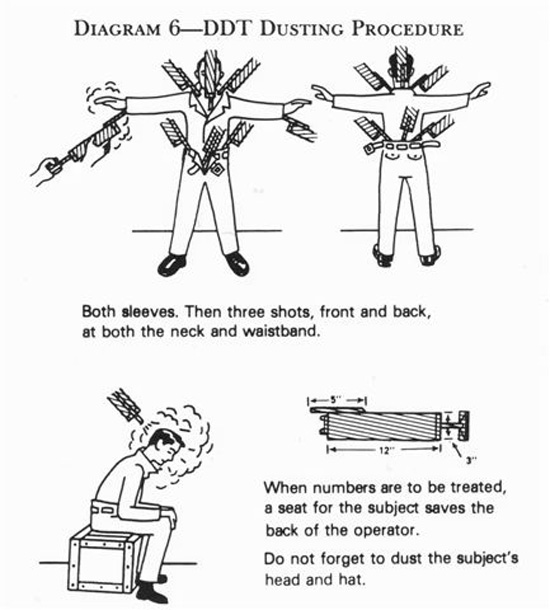
Drawing explaining the best method for DDT dusting procedure. DDT or Dichlorodiphenyltrichlororoethane was one of the well-known synthetic insecticides used in the period.
On 2 August 1944, the 122d General Hospital arrived from the United States to take over Hospital plant No. 4180, and two days later the 107th General Hospital also arriving from the Zone of Interior, took over the second site (the 29th Fld Hosp nevertheless remained attached to the 122d Gen Hosp until 11 Aug 44 for quarters and rations –ed).
Another important change in personnel took place early August, when 4 MAC Officers and 13 ANC Officers joined between 3 and 5 August 1944. In all, the period spent in the United Kingdom was extremely beneficial as a lot of experience was obtained in setting up and functioning of medical installations, and training of Medical and Surgical Technicians and the newly-assigned Nurses was accomplished. On verbal orders emanating from Headquarters ETOUSA, the organization (still without First Platoon –ed) left Kington on 11 August by train, arriving at the Staging Area outside Southampton, England, late that same night. The vehicles traveled separately in convoy carrying the housekeeping equipment only as the main bulk had already been shipped by truck the day before to the Swansea docks.
France:
The vehicles with accompanied personnel consisting of 2 Officers and 20 Enlisted Men, left the area 12 August, and embarked on LCTs, landing on Utah Beach, France 14 August 1944. The same day, 11 Officers and 108 EM boarded the S/S “Léopoldville”, while 13 Nurses embarked on the “Llangibby Castle” (2 Officers were lost to illness before departure). The Nurses debarked on Utah Beach 16 August at 2200 hours and joined the vehicle convoy. The personnel on the Léopoldville remained off shore another day completely loaded so that the personnel and equipment were only landed on 17 August at 1200 hours. They joined the preceding groups in Transient Area B, at Foucarville, France. There followed a short layover at the area during which a Chaplain joined the unit, after which the 29th was to proceed to a bivouac area near Osmanville, Normandy, France, on 18 August 1944. The medical equipment was only located 26 August after a thorough search at the beach and medical depots. Base Section No. 1 had meanwhile been redesignated Brittany Base Section with Headquarters at Rennes. On 22 August 1944, the organization (less First Platoon –ed) was assigned the mission of providing medical care and support in the evacuation of VIII Corps personnel, then engaged in fighting with the enemy around Brest. To aid this effort, 2 surgical teams from the 16th General Hospital were attached. They all moved by truck to Rennes on 27 August and thence by train to Morlaix, France, arriving at destination the following morning. Instructions now read that the 29th Field Hospital, less its First Platoon, was to act mainly as a Holding Unit located in the chain of evacuation between the 100th – 107th – 108th Evacuation Hospitals and the beaches. The two attached surgical teams were transferred and attached to the 108th Evac. The organization’s Nurses were split as follows: 5 went to the 100th Evac Hosp, another 3 Nurses went to the 107th Evac, and the remaining 5 were attached to the 108th Evac Hosp. 1 Officer and 41 EM were supplemented to the 666th Medical Clearing Company, which had just opened a Holding Station (bed capacity 240 –ed) for air evacuation at an airstrip approximately one mile from Morlaix. Their specific mission was to assist in loading of C-47 transports. The remainder of the unit, 12 Officers and 67 EM was moved to a field in Lesmaës, a commune of Plestin-les-Grèves, situated twelve miles from Morlaix. Through the period ranging from 28 August to 1 October 1944, a total of 4,058 patients cleared through the unit. The highest census reached on 21 September was 1,328.
The Evacuation Hospitals mentioned earlier were installed under canvas between 15 to 20 miles from the city of Brest. Casualties were evacuated by ¾-ton ambulances over approximately 40 miles of surfaced road, either to the 666th Medical Clearing Company at the airfield outside Morlaix, or to the 29th Field Hospital installations at Lesmaës. Weather remained an important factor for air evacuation, and additional space under canvas (pyramidal tents were mainly used –ed) was provided for patients who had to remain on litters. Evacuation further depended upon the number of LSTs present on the beach at the Mont St. Michel, the sufficient number of personnel to load and/or unload the vessels, and the tides. As the latter was the controlling factor, evacuation took place at any hour of the day or night. If ships were available and aircraft were not, patients were evacuated by boat from both Holding Stations. Other units involved in evacuation and operating Air and/or Rail Holding Units, were the 7th – 9th – 12th and 28th Field Hospitals, the 77th Evacuation Hospital, the 93d Medical Gas Treatment Battalion, and the 425th and 428th Medical Battalions –ed).
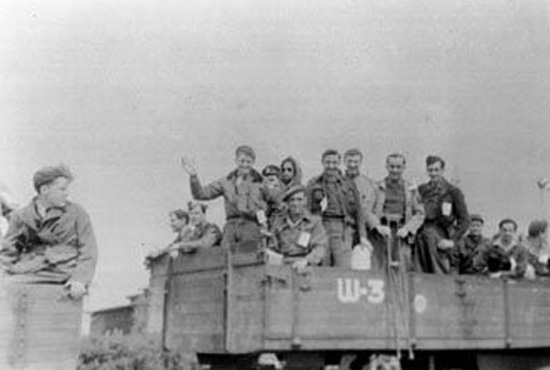
13 May 1945, Germany. A group of liberated Allied PWs is being brought to a nearby airfield for evacuation by B-17 bombers. Their final destination is France and one of the “Cigarette” camps where they will be taken for further processing and treatment prior to return to the Zone of Interior.
Medical care amounted mostly to making the patients comfortable. Hot meals were served and special emphasis was placed on making certain that the patients were fed before evacuation to the ships. If sulfonamides or penicillin therapy had been instituted or was deemed necessary, it was continued or started as the case might be. One operating table was set up in case of emergency, but surgery was used in the main for changing maggot-infested dressings and occasionally for applying or renewing a cast. All Officers and Nurses were housed in pyramidal tents and the Enlisted Men in individual pup tents in a nearby field. Separate shower facilities were available for the Nurses as for the male Officers and EM. The mess was excellent, with ambulatory German PWs employed as KPs for the enemy PW patients. The number of personnel varied from the opening of the Holding Unit, as a Dental Officer joined on 10 September, but mainly because the First Hospitalization Unit eventually rejoined the organization on 15 September 1944, thus reuniting the entire 29th Field Hospital for the first time since 22 May 1944! The First Platoon had departed from Ayre, Scotland on the morning of 26 August, traveling first to Kington, England for a one day and a half stay, thence proceeding to the Staging Area, arriving there on 28 August 1944. It left on 31 August reaching Normandy in the afternoon of 1 September 1944, debarking around 0300 hours, 2 September, and from there moved on to the Medical Staging Area four miles south of Sainte-Mère-Eglise, Utah Beach Command, where it was to bivouac until 14 September, carrying out routine duties. On that day, the Platoon left the area, entraining out of Chef-du-Pont on Hospital Train No. 15 with destination Rennes, Brittany, where it arrived at 0800, 15 September 1944. From Rennes, the entire personnel were transported by way of ambulances to the 29th Field Hospital Holding Unit located at Lesmaës. As no equipment had arrived yet, they were assigned to help the Holding Unit there…
Because of an urgent need for hospital care for the service troops around Morlaix it was necessary to dispatch one Platoon to open a Station Hospital near the area. A field on high ground about one mile on the main road to Rennes was selected. The Third Hospitalization Unit with 5 Officers and 55 Enlisted Men took off on 16 September and commenced establishing the hospital. Four pyramid tents were pitched together to serve as wards and house up to 30 patients; another 5 tents were grouped for surgery with a separate sterilizing tent set up to the rear. The necessary shock room, scrub room, operating room, and central supply store were all established with adequate provision for a motor pool, a kitchen tent, mess halls, Officers, Nurses, and Enlisted Men’s quarters. The new station opened for patients at 0900 hours, 19 September 1944. As the operational work increased, Headquarters Section and First Hospitalization Unit joined 4 October, leaving Second Platoon at Lesmaës. All personnel on DS with the Evacuation Hospitals were recalled and ordered to return to their parent unit. To reinforce the organization, an Ambulance Platoon consisting of 1 Officer, 23 EM, and 12 ¾-ton ambulances was attached on 6 October, supplemented by the Headquarters and Headquarters Detachment of the 237th Quartermaster Laundry Battalion on 10 October 1944.
During the 58 hospital days spent near Morlaix ending 16 November 1944, the unit (less Second Platoon –ed) received 973 patients. Total bed capacity ever reached was 155. Out of the 973 patients, 406 were German Prisoners of War.
Second Platoon, which remained at Lesmaës after closing for patients as of 1 October 1944, remained in bivouac until 22 October, when it was ordered to move to Bothiquery, near Landerneau, to set up another Station Hospital. It was thought at the time that part of the Port of Brest would be utilized, but this did not materialize. A château on the grounds was selected to billet the Nurses. The main hospital installation was to be on the lawn, and the closely surrounding fields were to become the EM’s tented quarters, with mess, and an extra area for expansion. The main drawback of the site was that access was over a very rough 2 ½-mile gravel road. Orders were received 25 October, three days after arrival, to cease works and await further orders. In the end the Second Hospitalization Unit was put at the disposal of ComZ, ETOUSA, for any further use.
On 7 November 1944, verbal notification was received that Second Platoon would move by truck to Antwerp, Belgium, and on 9 November written orders confirmed this.
Belgium:
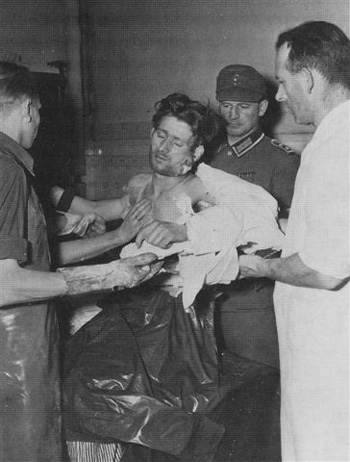
Spring of 1945. German medical staff treating some of their PWs at an American PW Hospital. This could be at one of the PWTEs set up in Germany.
The move was accomplished for personnel and equipment using some of the unit’s own transportation consisting of one ¼-ton, two ¾-ton ambulances, plus five 10-ton trailers, three 2½-ton trucks, and three 1½-ton personnel carriers. On 12 November 1944, the organization closed camp and left Landerneau at 1530 hours, arriving at the St. Jozef Preventorium, Pulderbos, Belgium, 15 November around 2300 hours. The group had a strength of 6 Officers, 5 Nurses, and 54 Enlisted Men. Upon arrival, the unit was relieved from assignment to the Brittany Base Section and attached to the Channel Base Section. Its mission was to operate the Pulderbos site as a Station Hospital, starting with 150 beds and expanding as rapidly as possible.
Meanwhile, the First, the Third Hospitalization Unit, and the Headquarters Section had equally received orders to join the Second Platoon in Belgium. One Hospitalization Platoon belonging to the 49th Field Hospital was sent to relieve the 29th units at Morlaix, France. The Hospital left Morlaix by train bound for Belgium on 17 November, with 15 Officers, 13 Nurses, and 104 EM, including the remaining equipment. The vehicle party accompanied by 1 Officer and 25 Enlisted Men left by convoy on 18 November 1944. When the main body reached Pulderbos on 21 November, the hospital was running and receiving patients. Most patients came from surrounding Antiaircraft Artillery units located around the Port of Antwerp (protection against flying bombs –ed).
The St. Jozef Preventorium was situated approximately 20 miles from Antwerp, Belgium. The building at Pulderbos was still in a state of construction and when originally taken over by the 100th Evacuation Hospital in October of 1944, kitchen dishwashing facilities and installations for a scrubroom in surgery had been authorized but not implemented. They were not put in place until the 29th arrived. The main problem that remained was the road of access with vehicles breaking down while attempting to pass it, even endangering the patients during transportation. Consequently on 26 November 1944, First Platoon moved to St. Antonius, Brecht, the proposed site of the 30th General Hospital, about five miles distant. The buildings belonged to a Belgian Asylum for the Insane and had recently been vacated to allow the advance party of the 30th Gen Hosp to move in. The operation of the St. Antonius site was done under adverse conditions. Although there was central heating, there was no gas for fuel. The only way was to heat the rooms with local coal stoves or Davis-top tent stoves. Also the quarters for staff and personnel remained unheated and damp. Washing and latrine facilities were few, there was no hot water, and due to the cold and damp in quarters a good many respiratory infections occurred. Luckily, messing of patients and personnel was arranged for with the 30th General Hospital who used the kitchen facilities in the building. In the 20 days of operation, a total of 426 patients were received (originally bed capacity was 90, but this was soon increased to 145). The patients received included Army, Navy, civilian, and Allied personnel.
After the works were successfully concluded, the Engineers released the site at Pulderbos for operation. The Hospital reopened for admission on 16 December 1944. It was figured that 350 patients could be cared for, and following some adaptation and modification, authorization was secured through American and British Engineers. Some electricity problems occurred but these were overcome with the help of additional T/E generators. The central heating plant was supplied with an extra gasoline pump to boost circulation. Sanitation, latrines, washing and shower facilities were adequate. Because of the large amount of floor space requiring cleaning, Belgian labor was used to supplement the unit’s personnel. From 16 December until 31 December 1944, 244 patients were admitted.
On 25 December 1944, the Officers, Nurses, and Enlisted Men celebrated Christmas Dinner in the best traditional Army style, with a separate dinner being served to the patients. In addition Santa Claus gave out American Red Cross parcels to the patients in the morning, and a local orchestra from the city of Antwerp played for patients and personnel in the afternoon. The EM even put up an excellent show. On 31 December 1944, the 29th Field Hospital completed its 28th month of active service. It had traveled 12,000 miles since the previous year. The organization’s strength at the close of 1944 was 22 Officers, 18 Nurses, and 185 Enlisted Men.
Operations at the St. Jozef Preventorium lasted from 21 November 1944 until 19 April 1945. Patients received belonged to units servicing the Port of Antwerp and also included members of the Antiaircraft Artillery groups (Antwerp Antiaircraft Artillery Command, designated “Antwerp X Command” –ed) providing protection against V-1 and V-2 bombs. A grand total of 2,550 patients were treated during this period, including 158 Merchant Mariners, 90 US Navy crewmen, 8 British troops, and 9 Belgian civilians. Water drainage at the site was poor due to the prevailing high water table and flat terrain and these factors raised problems of mosquito and fly control, prohibiting adequate removal of effluent waste. Rectification was undertaken with assistance from British Engineers. Any emergency, psychotic, and psycho-neurotic cases were evacuated to the 30th General Hospital, about 4 miles away and actually more conveniently located in relation to the Antwerp area. For operations the 22 Officers, 18 Nurses, and 185 Enlisted Men were supplemented by 50 Belgians, male and female, who did overall cleaning and dishwashing (huge amount of floorspace, numerous windows, and lack of own personnel, being on TD at the Port of Antwerp). The lack of personnel increased, as 2 Officers, 2 Nurses and 25 EM were sent to Brussels, Belgium, on 29 January 1945 to set up a 50-bed Dispensary at the George-Henry Leave Club, part of the US Army Leave Center, Brussels. It opened 3 February, and was turned over to the 30th Gen Hosp on 20 April 1945, due to shortages of personnel and preparatory to leaving Belgium. Notwithstanding the personnel issue, 1 Officer and 15 Enlisted Men were still placed on TD at La Louvière, Belgium on 22 March 1945, in order to hold a site previously occupied by the 77th Evacuation Hospital until arrival of the 3d Station Hospital. This detachment returned to duty with the parent unit on 11 April 1945. In order to somehow alleviate the burden on the 29th staff at Pulderbos, 2 Officers, 2 Nurses, and 15 EM arrived on 12 March 1945 on TD from the 195th General Hospital (they remained until 14 April –ed).
Training schedules were in effect from mid-February 1945 until the unit was alerted for movement, and included all available personnel. It became necessary because of the loss of a considerable number of older men experienced in the unit, who suited Army physical standards for transfer to Infantry training, later replaced by limited assignment personnel. Also incorporated in the training program were a series of orientation lectures supervised by the I & E Officer, and a full athletic program. Four Officers were sent to the Information & Education School in Paris, France. Recreation was available through passes to Antwerp (at first limited due to the continuous hazards of V-1 and V-2 bombings –ed), but later expanded not only to Antwerp, but also to the surrounding towns and Brussels. In addition, allotment of passes to Paris and leaves to Great Britain were offered to the personnel. Movies were shown almost every night, and with the coming of better weather, outdoor sports and games were encouraged. Dances were organized and sufficient numbers of British ATS girls invited.
Germany:
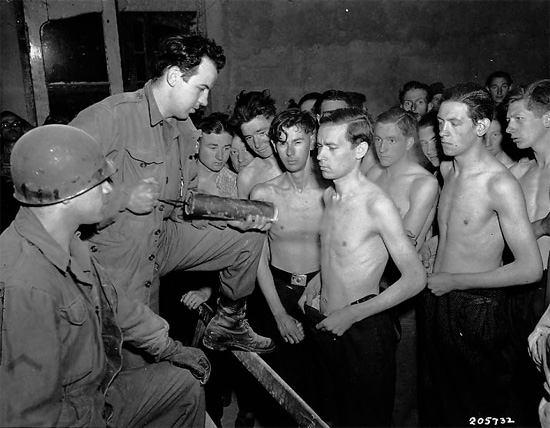
Germany, 1945. Medical personnel ready for delousing a group of youngsters. They appear to be in good condition; maybe they are German soldiers although no one seems to wear any identification tags …
Pursuant to orders received from Channel Base Section, the 29th Field Hospital moved from Pulderbos, Belgium, to Continental Advance Section, Mannheim, Germany. The move took place in three groups:
- An advance vehicular convoy party left 21 April 1945.
- The main vehicle party left 24 April 1945.
- The remainder of the unit left by train 24 April 1945.
The three groups arrived at their destination 26 April 1945. The Surgeon CONAD (Continental Advance Section) indicated the unit’s missions: one Platoon was to remain in the vicinity of Mannheim to set up the necessary hospitalization for Displaced Persons. Two Platoons were to proceed to an airfield, R-44, located at Goppingen, Germany, and establish an Air Holding Unit for evacuation of casualties.
- The Third Hospitalization Unit remained in Mannheim and selected a school building, which unfortunately proved unsatisfactory due to the absence of latrine facilities; moreover the high water table in the nearby fields precluded adequate drainage and latrine facilities to establish a hospital under tentage. Consequently, Third Platoon, including the Nurses of the Second Platoon, were attached to the 26th Field Hospital which was operating two of its Hospitalization Units in Rheinau, taking care of US Army personnel as well as DPs. This group would continue operations until 26 June 1945. Due to the volume of work on the site, all the hospital’s Nurses and 3 more Officers joined Third Platoon helping out with an increasing patient census soon reaching over 400.
- First and Second Hospitalization Units traveled to Goppingen as ordered. It was soon discovered that the airstrip was unsuitable for handling large air transports. Furthermore the Allied Armies had advanced so rapidly in enemy territory that Goppingen was already too far to the rear. A reconnaissance of airfields around Augsburg was made, but as none were found that could be cleared and made available, immediate plans for air evacuation were discarded.
On 2 May 1945, the Nurses working with First and Second Platoons were attached to the 26th Fld Hosp in Rheinau, Germany, and First plus Second Platoons moved with their equipment to Heilbronn, Germany, to provide hospitalization for a temporary Prison Enclosure, PWTE C-3 (Prisoner of War Transient Enclosure No. C-3 –ed), in process of construction and already containing close to 100,000 German PWs. Plans called for setup of a 1,500-bed hospital the equipment of which was to be entirely German. However, due to the initial lack of German supplies, the equipment pertaining to the Second Hospitalization Unit, plus 15 extra ward tents obtained through CONAD, was used.
On 6 May 1945, the Hospital at PWTE C-3 opened with an initial capacity of 160 beds. The projected 1,500-bed capacity was reached by 24 June, at which time the number of patients being treated was 1,353.
The Hospital staff was composed of German Medical Officers, Noncoms, and Enlisted Men working under the supervision of 29th Field Hospital personnel. The hospital proper was installed within the enclosure and on fairly high ground. There were 3 wooden buildings (96 x 20 feet), for professional services and surgery. Wards and living quarters for the German personnel were in tents, with enemy tentage gradually replacing American equipment. Twelve latrines (fly-proof) of a double 16-hole QMC-type were distributed over the area with the aim to keep them as far as possible from the Hospital kitchen. Garbage pits and wash racks were available to all wards, cooking was done on German ranges, grease traps were constructed, and an underground cellar was built for storage of perishable food, water was piped to the Hospital and a suitable chlorinating process later installed. Large amounts of DDT powder were used against the initially high louse infection. Laundry facilities were built for the operating rooms and patients’ towels, and a 32-man shower unit installed.
As of 26 June 1945 patient census was 1,391. The total number of patients having received hospital care was 2,806, and in addition 3,751 patients were treated on an ambulatory status in the dental, surgical, medical, and EENT Clinics, and the available Dispensary.
Work was then commenced on the construction of a similar 1,500-bed Hospital at PWTE C-4 on 14 May 1945. This enclosure was adjacent to PWTE C-3. In general and during the first phase, the First Platoon equipment was used until such time as German equipment became available. The Hospital opened for patients on 17 May with an initial bed capacity of 144. Likewise, German Medical Officers and EM staffed the installation. Layout and facilities were quite similar to PWTE C-3; considerable energy was expended in the construction of a suitable framework to support the captured tropical tentage which had meanwhile become available. Drainage was accomplished, ditches dug, and the problem of mud solved by the use of gravel paths and crushed rock roads. Patient census reached 994 by the end of June, with a total bed capacity of 1,055. In all, 1,983 patients received hospital care and another 2,869 patients received miscellaneous treatment at the various clinics.
One of the major problems encountered after establishing both Hospitals at PWTE C-3 and PWTE C-4 was that of supply, more particularly medical supply. German, Italian, and Hungarian tentage gradually became available, with folding cots and wool blankets supplied by the US Army. German medical equipment was obtained from various captured German medical supply depots, but it was slow, irregular, and incomplete mainly owing to the lack of transportation and the limited amount and restricted choice of such supplies. The administration was efficiently run by German PW clerks which needed very little or no supervision.
In addition to the regular hospital care, the 29th was charged with the operation of Medical Dispensaries in each of the PW Enclosures. Initially 2 German Medical Officers, assisted by 10 German Medical Enlisted personnel, one or two of whom spoke English, were picked as a basic staff for a cage of 5,000 PWs. At first, general care, bedding, and shelter at the two PW Hospitals were meagre and problems were further incurred by heavy rains followed by an intense heat wave. Since prisoners were without shelter, little or no water and little food, the situation resulted in a high illness rate. Prostration, heat strokes, and diarrhea were numerous. Only as from 20 May were there enough beds for increased admission of the sick. The work of the 29th Field Hospital in setting up hospitals for two PW Enclosures was completed with very little American equipment still in use, and the German PW medical staff was deemed capable of administering the hospitals and caring for the patients under the supervision of only a skeleton group of United States personnel. Operating and managing a German PW Hospital at Heilbronn was quite a new experience for the organization.
A limited training period was to follow in June-July 1945, the larger part of it being made up of I & E lectures and sports. Excellent swimming facilities were available at a pool in Heilbronn. The work at hand and the rapid turnover of personnel ruled out further training in specialties. Leaves and passes continued to be allotted for Officers, Nurses and Enlisted personnel, with the Officers receiving 1 leave to England, 1 to the French Riviera, and 2 to Paris; the Nurses receiving 4 leaves to England, 4 to the Riviera, and 13 to Paris; and the Enlisted Men being granted 4 furloughs to England, 5 to the French Riviera, and 28 passes to Paris and Brussels.
A total of 10 Officers, including Nurses, received promotions, and 55 promotions were made among the EM. Aggregate strength of the 29th Field Hospital as of 26 June 1945 was 22 Officers – 16 Nurses – 185 Enlisted Men.
Awards Army Good Conduct Medal – 29th Field Hospital
Kiska – 24 (awarded 26 Jan 44)
Kiska – 24 (awarded 9 Feb 44)
United Kingdom – 36 (awarded 11 Jul 44)
United Kingdom – 13 (awarded 23 Jul 44)
Awards Purple Heart Medal – 29th Field Hospital
Antwerp – 2 (awarded 8 Dec 44)

Christmas Season 1944 special message addressed by Colonel Albert E. Hermann, MC, Commanding Officer 29th Field Hospital, to his troops while stationed at St. Jozef Preventorium, Pulderbos, Antwerp region, Belgium (November 1944 to April 1945).
The MRC Staff want to thank their regular contributor Lynn F. McNulty, son of Captain Frederick J. McNulty (ASN:O-526873) for his most generous help and assistance. He supplied them with a number of precious copies of annual history reports pertaining to the 29th Field Hospital, which helped with editing this concise Unit History. The authors are still looking for additional data covering the final activities of the Hospital in the ETO and its return to the ZI, as well as a complete Personnel Roster. Thank you.
